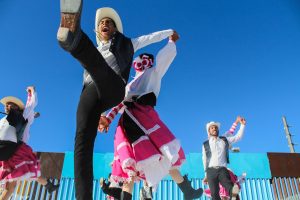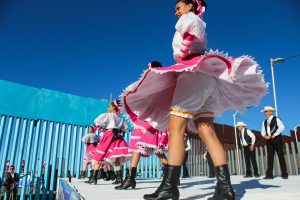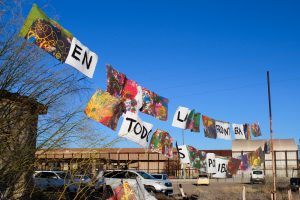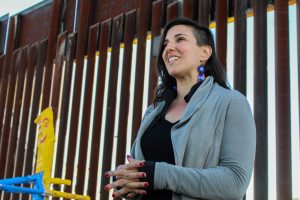- Slug: BC-CNS-Border Dance and Music. 600 words.
- Photos available (thumbnails and captions below)
- Video here.
By ANGEL MENDOZA
Cronkite News
AGUA PRIETA, Mexico – Dancers, artists and residents from Arizona and Sonora joined forces Saturday as part of the final performance of the “Shared Spaces: An Evening of Dance, Music and Poetry at the US/Mex Border.”
Dozens of people gathered near the Douglas port of entry, which separates Douglas and Agua Prieta, Sonora, to promote cultural awareness and encourage dialogue about social justice issues affecting the borderlands.
The event stage, half in Arizona and half in Mexico, brought young dancers from both Mexico and the United States, some in traditional Mexican outfits, to perform Mexican folkloric music, modern jazz pieces and a composition that took inspiration from the student performers.
“Borders are – a lot of times – seen as something that separates, and today I think we proved that a border can be something that connects,” said Ana Maria Alvarez, the 2018 artist for the Binational Arts Residency, a female-led collaborative that directed the border performance.
Alexa Enriquez, 14, has been a part of Ballet Folklorico Aztlan for eight months. She was one of the performers from the Mexico side, and she said she felt a sense of pride while dancing.
“All of this is a beautiful experience,” she said in Spanish. “It is something that I’ve never done before. I am very happy to be a part of this experience and proud to be in Mexico.”
On the Sonoran side of the border, Tolley Rippon, a student and fine arts lab tech from Cochise College in Douglas, spearheaded art activities, which included encouraging children to paint on white canvases.
“To be down in this area and experience this whole culture, at first, was slightly overwhelming and is now one of the most beautiful things that I’ve participated in,” said Rippon, who originally is from Oregon.
Several participants said the performance played an important role in highlighting the value of close relationships between the arts communities in Arizona and Sonora.
“We want to empower our youth and our artists in this area because the borderlands are such a fertile space for creative expression,” said Jenea Sanchez, founder of the arts organization Border Arts Corridor.
Gabriella Munoz, the artist programs manager at the Arizona Commission on the Arts, said their efforts highlighted “the expertise of our multiple artistic communities and the vibrancy of those communities.”
At the end of the event, performers and spectators gathered along the metal border fence, reached through the narrow bars and touched hands.
“That was definitely something that was not scripted,” Sanchez said. “It was spontaneous, and I think that it stemmed from the feeling that the artistic expression left in all of us – we just wanted to touch, physically.”
Although a wall divides the two communities, she said, “we are trying to show the world that truthfully we are one people.”
As the festivities ended, Sonorans went home through the colorful but dilapidated buildings near Agua Prietas’ industrial sector, while Arizonans headed to a commercial parking lot.
“At the border everything is possible,” a banner read in Spanish.
Alvarez, one of the event’s choreographers, called the experience a whirlwind of creative inspiration.
“The amount of deep personal connections, the sharing of stories that has happened … honestly it’s given me so much hope for humanity,” she said. “It’s a testament to how this giant fence, made of metal, is really just that. … It’s a reflection of what could be possible if our governments could participate with each other in this way.”
Agua Prieta resident Carla Gonzalez, 11, wearing a traditional Mexican beauty pageant dress and accessories known as China poblano – was among those who lingered after the performance.
“I hope that we can continue doing more things like this so that the children can learn that we are not two, we are one,” she said in Spanish.
“Like they say, ‘without borders.’ ”
Cronkite News reporters Lillian Donahue and Melina Zuniga contributed to this article.
[su_divider top=”no” size=”1″ margin=”10″]
[sub-tag]
For more stories from Cronkite News, visit cronkitenews.azpbs.org.
^_=




